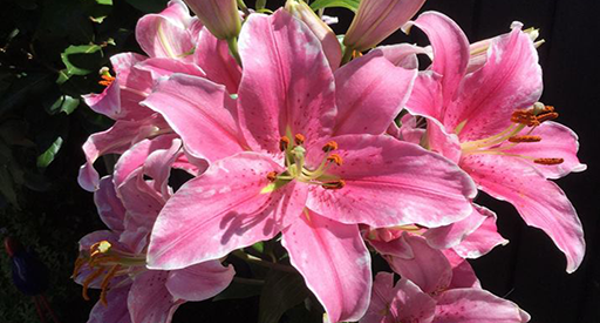
Lilies are adored all over the world. A popular cut flower, Lilies look good added to arrangements or just on their own. The way Lilies hold their flower heads up high to draw you into their blooms is appealing. The Christmas Lily strikes a chord with Kiwis. The vases of freshly picked, fragrant stems on the Christmas table bring back wonderful memories of days spent with friends and family.
3 steps to planting lilies
prepare
As bulbs go Lilies are relatively easy to grow. Lilies main requirements are simple – food, sun, water and support for taller-flowering stems. They’re happy in containers too; there is no excuse for even the smallest of gardens not to have a Lily or two. With careful planning and by choosing a combination early, mid-season to late-blooming types, you can have Lilies in flower from December – March.
Ideally Lilies require a spot where they will get at least half the day’s sun. In exceptionally hot and dry areas they may struggle to bloom. Keep bulbs watered once the soil warms and new growth appears. Good drainage is vital as the plant will die down and nestle under the soil for the winter months after flowering. If the soil is too wet, the bulbs will rot and die. Bulbs can be lifted each autumn and replanted in spring.
Some favourite varieties to look out for are Asiatic Lily, Casablanca Lily, Christmas Lily, Climbing Lily and Oriental Lily.
Like building a house a good foundation is the key to success in your garden. The better the soil, the better your plants will grow. If you are starting with an existing garden bed dig in organic matter like Tui Sheep Pellets and Tui Compost to your soil. Then you can add a layer of Tui Bulb Mix. To help with flowering, use a side-dressing at planting time of Tui Bulb Food. Check individual planting instructions. Plant each bulb twice the width of the bulb. Always water well after planting.
PLANT
The best times to plant are early in the morning, or late in the day so the plants aren't exposed to the hot sun straight away. Always water plants well before and after planting.
Directions for planting in garden beds
- Water plants thoroughly before planting and allow to drain.
- Dig a hole, approximately twice the depth and width of the root ball of your plant.
- Gently loosen the root ball of your plant and position the plant in the centre of the hole.
- Fill in with Tui Bulb Mix.
- Press soil gently around the base of the plant.
- Water your plant well and continue to water regularly.
Directions for potting plants
- Water plants thoroughly before potting and allow to drain.
- Half fill your container with Tui Bulb Mix.
- Gently take the plant from the current container, loosen the root ball and remove any loose or dead plant material and roots.
- Position the plant in the centre of the new container and fill with Tui Bulb Mix up to 3cm from the top.
- Gently firm mix around the base of the plant. The mix should be at the same level on the plant as it was in the previous container.
- Water your plant well and continue to water regularly.
nourish
Feed your plants and they will reward you. Replenishing the nutrients used by your plants ensures your plants grow to their full potential. Feed your Lilies with Tui Bulb Food or use an all-purpose variety such as Tui NovaTec® Premium Fertiliser. Fertilise at planting time and again in spring to ensure a blooming display.
A well-watered, well-nourished garden will have a better chance of keeping insect pests and diseases at bay. While your Lilies are growing regularly apply a dose of Tui Organic Seaweed Plant Tonic to give them a welcome boost.
It is recommended to lift and divide bulbs every few years to maintain bulb vigour and flower production. Overcrowding of bulbs in the garden is a common problem, which results in smaller blooms the following years.
If soil is too wet, bulbs will rot and die.